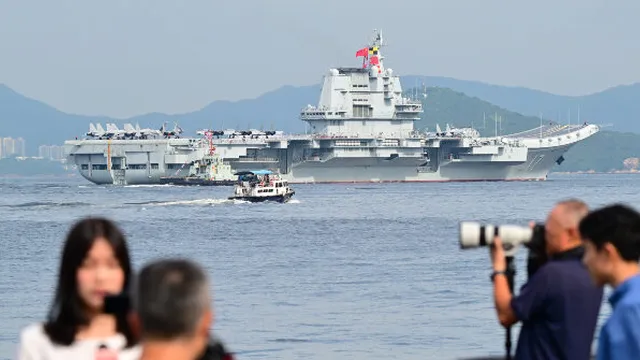
Chinese aircraft carrier Shandong docks in Hong Kong to promote patriotism
2025-07-03 08:32- The Shandong, China's first domestically-built aircraft carrier, entered Victoria Harbour escorted by guided missile destroyers and a frigate.
- The visit coincided with the 28th anniversary of Hong Kong's return to China and aims to boost national pride.
- The arrival reflects the government's ongoing efforts to promote patriotism and emphasizes military modernization amid recent political tensions.
Express your sentiment!
Insights
On July 3, 2025, China’s first domestically-built aircraft carrier, the Shandong, entered Victoria Harbour in Hong Kong, signaling a significant event in the context of China's expanding military capabilities. The Shandong was accompanied by a task force, including guided missile destroyers Yan'an and Zhanijiang, along with a guided missile frigate, Yuncheng. This arrival coincides with the 28th anniversary of Hong Kong's return to Chinese sovereignty and indicative of the government's efforts to reinforce national pride in the region following the crackdown on pro-democracy protests in 2019. The warships' docking was met with a ceremonial welcome organized by Hong Kong’s government, emphasizing the themes of national defense and development. Chief Executive John Lee Ka-chiu asserted that the fleet's arrival symbolized the strong foundations of national security and its importance in maintaining stability and prosperity in Hong Kong. Lee noted the immense effort and sacrifices that have been made in achieving this stability, positioning the military presence as a reminder of the comprehensive modernization of China’s naval forces. The visiting ships were scheduled to be open to the public for tours from July 4 to 6, with all 10,000 tickets swiftly claimed by eager residents. The Shandong alone had been allocated 2,000 tickets, demonstrating the public interest in witnessing the country's military assets firsthand. This initiative is part of a broader strategy by the Chinese government to foster patriotism in Hong Kong amidst a backdrop of recent struggles for civil liberties and social dissent, illustrating how military showcases serve political purposes in the city's unique administrative context. In recent years, military exercises in the South China Sea and near Taiwan have heightened regional tensions, with the Shandong playing a critical role in these demonstrations of force. As the aircraft carrier joins the ranks of China's growing naval fleet, its arrival is not just a display of military prowess but also a calculated effort to instill a sense of national identity and unity among Hong Kong residents in an era characterized by political upheaval and uncertainty.
Contexts
The impact of military presence in Hong Kong is a complex issue that encompasses socio-political, economic, and cultural dimensions. Following the historical transfer of sovereignty from Britain to China in 1997, Hong Kong has operated under the framework of "one country, two systems," allowing a unique blend of Western legal and social systems alongside mainland Chinese influence. The military presence, particularly from the People's Liberation Army (PLA), plays a pivotal role in shaping public perception and policy within Hong Kong. While the military's original objective was to ensure stability and national security, increasing visibility and activities of the PLA have led to heightened tensions and concerns among local residents pertaining to civil liberties and autonomy. The military’s presence in Hong Kong has significant implications for the region’s economic environment. While the UN and local policies have aimed to promote a free market and attract international investment, foreign business entities are often wary of the perceived risks associated with the military's influence. Investor confidence can be adversely affected by the uncertainties surrounding the role and actions of the PLA, contributing to fluctuations in the financial market. Moreover, protests and the push for democratic reforms have drawn attention to human rights concerns, further complicating the economic landscape and the relationship between Hong Kong and other global financial centers. In terms of social dynamics, the military presence has transformed societal sentiments within the city. Public opinion regarding the PLA is often polarized, with some viewing its presence as necessary for maintaining order in the face of potential unrest, while others see it as an encroachment on the freedoms promised under the "one country, two systems" framework. This dynamic is particularly evident in light of the large-scale protests that erupted in 2019, where the presence of the PLA served both as a deterrent against violent escalations and as a symbol of the diminishing autonomy that many Hongkongers fear. The military's role in public order displays a contrasting narrative of protection versus oppression, impacting the collective psyche of the population. In conclusion, the military presence in Hong Kong embodies a multifaceted influence on the region, intertwining issues of national security, economic stability, and social harmony. Understanding these dimensions is critical for policymakers, businesses, and citizens alike, as the balance between security and autonomy remains precarious. The future trajectory of Hong Kong will likely depend not only on the governance strategies employed by the central government but also on the evolving relationship between the military and the local populace, as each segment continues to define its position within the broader socio-political landscape.